
Diabetic retinopathy
Symptoms
The retina is a layer of tissue at the back of the eye that converts light and images into nerve signals, which are then sent to the brain, allowing us to see. Often, there are no noticeable symptoms until the damage becomes severe.
Symptoms of retinal damage may include blurred vision, gradual vision loss, floaters, shadows or blind spots in vision, and difficulty seeing at night.
Signs
During a diabetic eye exam, an eye doctor checks for signs such as blocked blood vessels, areas where vessels are enlarged, small amounts of bleeding, fluid leakage from vessels, and the abnormal growth of fragile new vessels. Regular eye exams are crucial for maintaining your eye health and preserving your vision.
Diagnosis
- Dilated eye exam
- Fluorescein angiography test
In this test, your doctor will inject a dye into your arm to monitor the blood flow in your eye. They will capture images of the dye as it circulates through your eye to identify any blocked, leaking, or damaged blood vessels.
- Optical coherence tomography (OCT) exam.
An optical coherence tomography (OCT) exam is an imaging test that uses light waves to capture detailed images of the retina. These images enable your doctor to assess the thickness of your retina and detect any fluid accumulation, if present.
TREATMENTS
Treatment options for early diabetic retinopathy are limited. Your doctor may recommend regular eye exams to monitor your eye health and determine if treatment is needed. An endocrinologist can help manage your diabetes effectively, which may slow the progression of retinopathy.
For advanced diabetic retinopathy, treatment varies based on the type and severity of the condition.
Photocoagulation surgery can help prevent vision loss by using a laser to seal leaking blood vessels through controlled burning. This procedure helps manage or halt leakage. The various types of photocoagulation and other treatment options include:
- Scatter photocoagulation uses a laser to create hundreds of tiny burns in the eye, typically performed multiple times, to help reduce the risk of blindness.
- Focal photocoagulation targets specific leaking blood vessels in the macula with a laser to prevent further worsening of macular edema.
- Vitrectomy is a procedure that removes scar tissue and cloudy fluid from the vitreous, the gel-like substance inside the eye.
PREVENTION
If you have diabetes, it’s crucial to keep the following levels in check to prevent diabetic retinopathy:
- Blood pressure
- Blood sugar
- Cholesterol
Other steps to prevent or manage the condition include:
- Quit smoking if you currently smoke.
- Engage in regular, moderate exercise several times a week. If you have retinopathy, consult your healthcare team to determine the most suitable exercises.
- Schedule annual eye exams.


